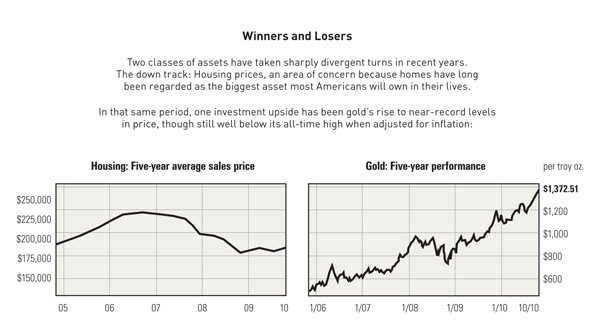
Fool’s Gold?
Much in the news of late has been gold. At the time of the meeting, gold was flirting with $1,350 an ounce, more than four times the price it had been selling at earlier in the decade.
“Gold has been a terrible hedge against inflation,” explained Matthews. Indeed, a person who bought gold at its 1980 peak of $850 and sold it this month would have done so at a substantial real-dollar loss. But Matthews believes that if the government “throws the dollar under the bus,” gold would be a “perfect hedge” against the dollar.
Adam Bold was not bullish on this market. He wonders whether gold has already played itself out. Said Bold, “I think the same people that were buying gold from the public a year ago at low prices are now selling it back to them at high prices.” Although he believes there is some place for gold in one’s allocation, he thinks investors should be wary. “Gold has these runs every so many years,” he said, “and if you don’t get out at the right time you may have to wait a decade to get even again.”
“We think there is a place for commodities and precious metals in a portfolio against risk,” said Scott Boswell, but he also cautioned that those who abandoned diversification did so at their own risk. “You have to be opportunistic around the edges,” said Boswell, “not at the core of your portfolio.”
Social Media's Impact
As with all professions, the emergence of the so-called social media has made at least some impact on the wealth-management business.
As Steve Toomey noted, the fact that wealth-management clients tend to be older means that advisers need not be overly worried about being on Twitter. Where he sees the advantage is from a professional perspective. Social media “have allowed me to tap into the ideas of others, share my ideas with others, and to learn collaboratively among people in the industry.”
Adam Bold’s operation is more aggressive in its application of social media. He has, for instance, a Facebook fan page. “I think if you ignore Facebook,” he said, “it’s at your own peril.”
Kristin Tyson volunteered that her staff was being trained to use LinkedIn in as a way to prospect.
K.C. Matthews identified an additional benefit: He and his colleagues are able to post their appearances on national media channels on YouTube. Said Matthews, “I’m not sure the typical CNBC watcher is also a YouTube person, so we are allowed to spread that message.”
Steve Harrison cautioned that social media had led to the flowering of the “I think” era. As Harrison observed, “The most popular two words on TV are, ‘I think.’ The worst two words in our business are, ‘I think.’” The media, he believes, have created more “experts” than the market can bear.
One effect of the proliferation of personal media, said Kelli Glynn, is the expectation of instant communication. The combination of the e-mail and smart phone devices has led clients to expect answers to questions on a Saturday, not just on a Monday.
This combination, agreed Jim Betterman, “is revolutionizing how I do business.” Much of that has to do with client contact. “In the old days, you used to meet at the office or at lunch,” he said. “More and more, the contact is going to be virtual.” For Betterman, it is not just the young clients who demand instant access. It is the older ones, as well.
“They don’t want to see you all the time,” said Betterman. “They just want to know things are being taken care of.” ![]()